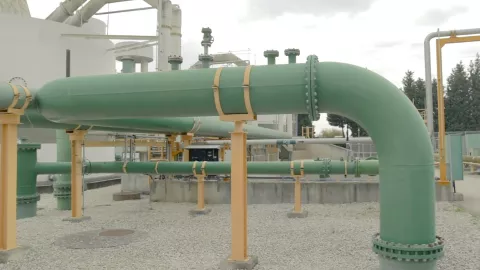Hydrogen is embedded in virtually everything around us and has been used, either experimentally or in practical applications, for centuries. In recent decades, several new technologies have emerged to produce and store it. There is a whole rainbow of colors to represent hydrogen according to its production methods.
Green hydrogen is expected to be the future, but the remaining hues continue to play an important role in industry and in the economy in general. Below is an explanation of each of the colors that can be associated with H2. Just select the color to find out where it comes from.
White Hydrogen
In addition to being an element present in water, plants and animals, hydrogen can also be found in its gaseous form, in underground deposits. It is a rare occurrence - particularly since it is odorless and colorless, making it difficult to detect - and there are no efficient and economically viable techniques to extract it.
Blue Hydrogen
Using the steam reformation technique, the most common so far, when released CO2 is captured and stored - in underground or underwater natural deposits - hydrogen is dubbed blue. There are also projects for the reuse of captured CO2, but CO2 emissions, which always end up escaping to the atmosphere - prevent it from being an environmentally efficient solution.
Grey Hydrogen
Steam reformation is the most commonly used method today, accounting for over 90% of the world's hydrogen production. For this process, natural gas or other fossil fuels are usually used, that upon being heated to separate the H2, also end up releasing CO2 into the atmosphere, which justifies its color and inefficiency.
Turquoise Hydrogen
Another experimental technology that is being studied is the turning of CO2 into a solid state. In other words, the raw material is natural gas or bio-gas, but from process, known as methane pyrolysis, solid carbon is resulted instead of CO2 emissions. This product can then be used for commercial applications in various industries: tires, paints, steel, graphite.
Rose Hydrogen
Another possible solution to obtain hydrogen is through nuclear energy. In this case, the electrolysis process is achieved using this energy, with the risks and radioactive waste that are always associated with it.
Green Hydrogen
Water and electricity produced by renewable sources, nothing else. Through electrolysis, hydrogen molecules are separated from oxygen one's, without any direct polluting emissions throughout the process, provided that the used electrical energy comes from renewable sources. The production of green hydrogen is still expensive, but its cost is expected to fall considerably in the coming years, which makes it the real hope for various sectors in terms of energy efficiency and positive effects on the environment.
Although there are multiple ways to produce, store and use hydrogen, pollution and the economic viability of some techniques rule out certain "colors", as they are solutions without a future. Green hydrogen is taking major steps towards matching gray and blue prices, which will make this technology not only environmentally efficient but also a creator of jobs and a driver of economic growth. The future of the planet includes green hydrogen.



